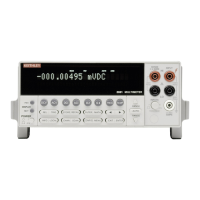IEEE-488 Reference
4-12
Sequence Condition Register
This is a real-time 16-bit
read-only register that constantly updates to reflect the cur-
rent arm layer status of the instrument. For example, if the
Model 2001 is currently in the scan layer of operation, bit B2
(In arm layer 2) of this register will be set.
The following SCPI query command can be used to read the
Sequence Condition Register:
:STATus:OPERation:ARM:SEQuence:CONDition?
The Sequence Condition Register and the Transition Filter
are used to set the bits of the Sequence Event Register. The
Transition Filter is discussed next.
Sequence Transition Filter The transition filter is made
up of two 16-bit registers that are programmed by the user. It
is used to specify which transition (0 to 1, or 1 to 0) in the
Sequence Condition Register will set the corresponding bit
in the Sequence Event Register.
The filter can be programmed for positive transitions (PTR),
negative transitions (NTR) or both. When an event bit is pro-
grammed for a positive transition, the event bit in the Se-
quence Event Register will set when the corresponding bit in
the Sequence Condition Register changes from 0 to 1. Con-
versely, when programmed for a negative transition, the bit
in the status register will set when the corresponding bit in
the condition register changes from 1 to 0.
The transition filter registers can be set or cleared by using
the following SCPI commands:
:STATus:OPERation:ARM:SEQuence:PTRansition <NRf>
:STATus:OPERation:ARM:SEQuence:NTRansition <NRf>
The transition filter registers can be read at any time by using
the following SCPI query commands:
:STATus:OPERation:ARM:SEQuence:PTRansition?
:STATus:OPERation:ARM:SEQuence:NTRansition?
Reading a transition filter register using the above query
commands does not affect the contents of the register.
The following operations will set (1) all the bits of the PTR
register and reset (0) all the bits of the NTR register:
1. Cycling power.
2. Sending the :STATus:PRESet command.
3. Sending the :STATus:OPERation:ARM:SE-
Quence:PTR 65535 and :STATus:OPERa-
tion:ARM:SEQuence:NTR 0 commands.
Sequence Event Register This is a latched, read-only
register whose bits are set by the Sequence Condition Regis-
ter and Transition Filter. Once a bit in this register is set, it
will remain set (latched) until the register is cleared by a spe-
cific clearing sequence. The bits of this register are logically
ANDed with the bits of the Sequence Event Enable Register
and applied to an OR gate. The output of the OR gate is ap-
plied to bit B1 of the Arm Condition Register (see paragraph
4.6.3). The following SCPI query command can be used to
read the Sequence Event Register:
:STATus:OPERation:ARM:SEQuence?
Reading this register using the above SCPI command clears
the register. The following list summarizes all operations that
will clear the Sequence Event Register:
1. Cycling power.
2. Sending the *CLS common command.
3. Sending the :STATus:OPERation:ARM:SEQuence?
query command.
Sequence Event Enable Register This register is pro-
grammed by the user and serves as a mask for the Sequence
Event Register. When masked, a set bit in the Sequence
Event Register will not set bit B1 of the Arm Condition Reg-
ister. Conversely, when unmasked, a set bit in the Sequence
Event Register will set the bit B1 of the Arm Condition Reg-
ister.
A bit in the Sequence Event Register is masked when the
corresponding bit in the Sequence Event Enable Register is
cleared (0). When the masked bit of the Sequence Event Reg-
ister sets, it is ANDed with the corresponding cleared bit in
the Sequence Event Enable Register. The logic “0” output of
the AND gate is applied to the input of the OR gate and thus,
will not set bit B1 of the Arm Condition Register.
A bit in the Sequence Event Register is unmasked when the
corresponding bit in the Sequence Event Enable Register is
set (1). When the unmasked bit of the Sequence Event Reg-
ister sets, it is ANDed with the corresponding set bit in the
Sequence Event Enable Register. The logic “1” output of the
AND gate is applied to the input of the OR gate and thus, will
set bit B1 of the Arm Condition Register.
The individual bits of the Sequence Event Enable Register
can be set or cleared by using the following SCPI command:
:STATus:OPERation:ARM:SEQuence:ENABle <NRf>
The following SCPI query command can be used to read the
Sequence Event Enable Register:
:STATus:OPERation:ARM:SEQuence:ENABle?

